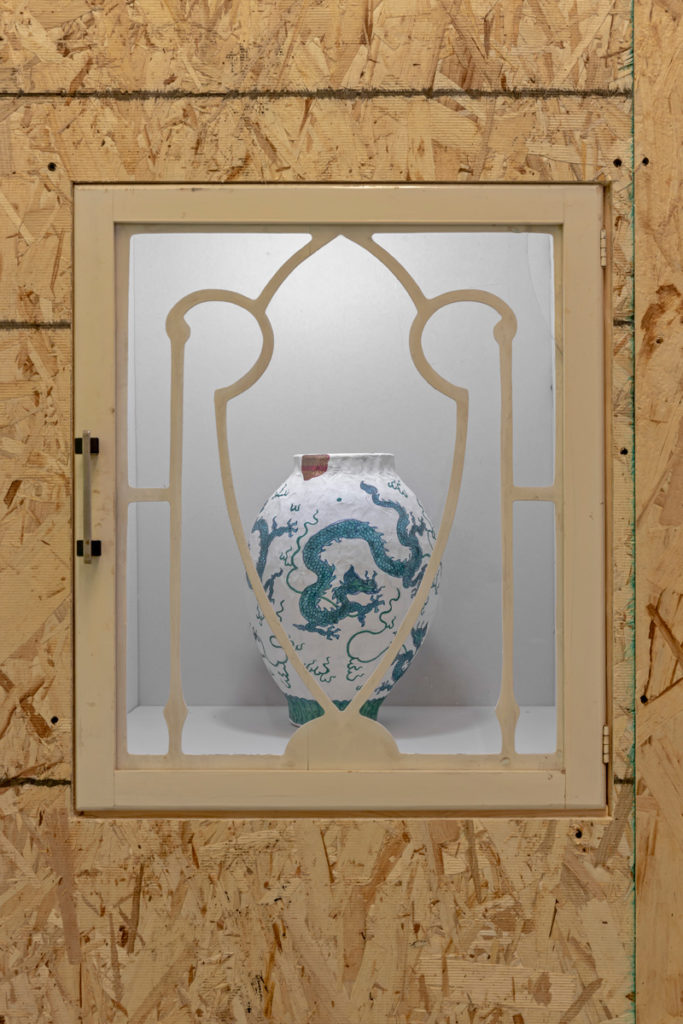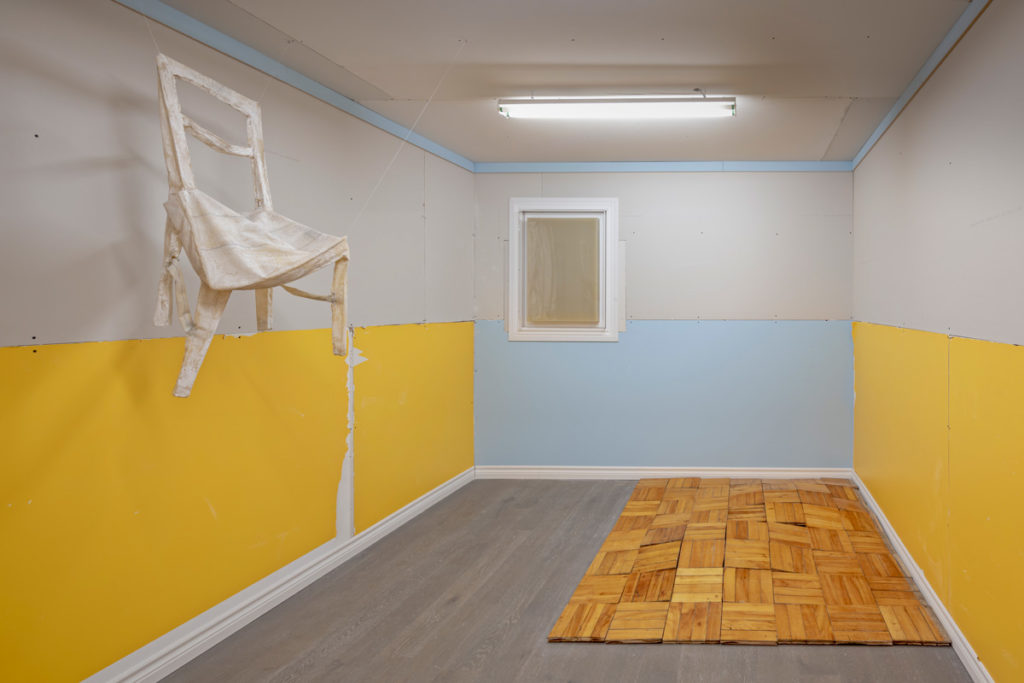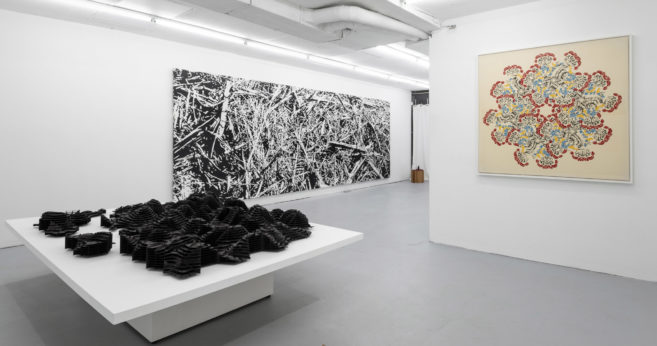When galleries tout about “transforming” space for immersive exhibitions, rarely do they succeed like the Koffler Gallery has in its current exhibition “Undomesticated.” Three floors—spilling out of the Koffler Gallery into surrounding rooms of Artscape Youngplace—have been turned inside out, construction-material guts now exposed; the typically pristine white space has been replaced with exposed OSB (oriented strand board), low ceilings and new laminate floors. Under the show’s curator, Mona Filip, and art director Nicolas Fleming, the exhibition of work by 24 artists is presented on reused and recycled building supplies, such as scuffed drywall and perforated panelling. Fleming’s construction aesthetic permeates and backgrounds all the exhibition’s artwork displays (there are many), which make up several “domestic” rooms seemingly frozen mid-assembly. It’s as if the display were sourced from a pile of condo-development offcuts, then fit together like a puzzle.
Many works not only refer to the exhibition’s overall “domesticity” thematic, but also playfully reference the exhibition format itself. Installed in non-traditional but thematically relevant ways, each artist’s practice fits, bends, fades and sticks onto Fleming’s custom frame. Karen Tam’s papier-mâché “porcelain” Chinese vases appear throughout the show in hallways, the kitchen and the dining room. These delicate, handmade simulacra mirror the exhibition as a whole—as an entity somewhat resembling its original referent, but which critiques the veracity of normative aesthetic systems by incorporating its own materiality.
Adrienne Spier’s Line of Furniture (2014–18) complicates artist-curator taxonomy by using discarded particle-board furniture that bends and leans next to a constructed hallway door and camouflages within Fleming’s display aesthetic (half of each board was submerged in water, so that when dried and pressed together, they resemble a miniature Tower of Pisa). Gwenaël Bélanger’s video Breakdown (2008–13) shows an infinitely falling 3D-modelled house, from which shingles, bricks and boards furiously fly off; it parlays the exhibition’s general upheaval of the domestic setting to expose the material bones of building (and exhibition) structures.
Iris Häussler’s framed wax wall works, blocks of translucent beige wax that barely reveal sunken objects, decorate several rooms. Häussler’s tools—including dirty pots, used ladles and an old electronic portable stovetop—sit in Fleming’s kitchen. Works like these live in ambiguous aesthetic territory, asking questions about where display ends and art begins (or whether there is even a difference). Indeed, even the material provenance of Fleming’s built environment references exhibition-making: much of the structural scaffolding is made up of previous Koffler Gallery drywall, complete with past exhibition vinyl and didactic writing. While setting out to complicate domestic settings and showcasing the plurality of such environments, the exhibition also succeeds in another layer of self-referential messiness: revealing the apparatus—and constructedness—of art-world roles.
Writing on the history of the artist as curator, Elena Filipovic asks, “What does it mean to shift attention from objects to exhibitions?” Fleming also asks—and maybe answers—this question by way of this multilayered vision; the entire project feels like a grand, three-storey collaborative artwork. And maybe artwork and display blend together almost too well. The nature of Fleming’s involvement tests the long-standing, ongoing and sometimes questionable role of the “artist curator,” and was certainly a test of my own willingness to revise my definitions of artist, curator, designer and installer. His off-kilter installation design (not to mention the inclusion of his own matching artworks—don’t try to jump on his drywall bed) combined with others’ work dissolves not only the visual-spatial boundaries that traditional museums and galleries like to uphold, but also our expectations around didactic information and wayfinding. The decision to do without any wall text while providing visitors with an exhibition map made the show feel at times like a treasure hunt to find each piece within the larger design—and like a proposition to embrace the exhibition’s immersive aesthetic medley.

Karen Tam, Dragon Jar, 2019. Papier-mâché, gouache, pigmented India ink. Koffler Gallery installation. Photo: Toni Hafkenscheid.

“Undomesticated,” 2019. Koffler Gallery installation. Photo: Toni Hafkenscheid. (Pictured: Sandra Brewster, Karen Tam, Lucy Howe)

Gwenaël Bélanger, Breakdown, 2008–13. Animated 3D video, 4 min 1 sec. Koffler Gallery installation. Photo: Toni Hafkenscheid.

“Undomesticated,” 2019. Koffler Gallery installation. Photo: Toni Hafkenscheid. (Pictured: Birthe Piontek, Karen Tam, Iris Häussler)

From left: Karen Tam, Pearl Divers (Café-au- lait), 2019. Papier-mâché, card, gouache, gesso, UV archival varnish; Prince Arthur’s Vase, 2016. Sequins, steel pins, Styrofoam, wool. Courtesy Pascal Desjardin and Roxanne Arsenault; Castiglione’s Insect Mimics: Morning Glories, Bamboo, and Hemeroplanes triptolemus, 2019. Sequins, Styrofoam, steel pins, felt; Guan ware (After Jean-Paul Riopelle), 2018. Papier-mâché, gouache, pigmented India ink; Autumn’s Luck (Famille Noire), 2018. Papier-mâché, gouache, pigmented India ink; Dragon Jar, 2019. Papier-mâché, gouache, pigmented India ink. Koffler Gallery installation. Photo: Toni Hafkenscheid.

 “Undomesticated,” 2019. Koffler Gallery installation. Photo: Toni Hafkenscheid. (From left, work by: Gunilla Josephson, Iris Häussler, Adrienne Spier)
“Undomesticated,” 2019. Koffler Gallery installation. Photo: Toni Hafkenscheid. (From left, work by: Gunilla Josephson, Iris Häussler, Adrienne Spier)






